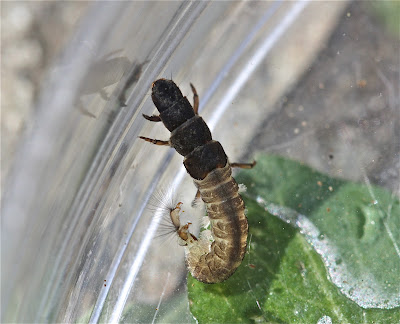Tuesday, July 31, 2012
Ceratopsyche sparna/Hydropsyche sparna: Identification of the Common Netspinner I Found in PA
This is the common netspinner (family: Hydropsychidae) that I found in Roaring Creek (between Catawissa and Danville) on July 21st. I've now been able to identify this as Ceratopsyche sparna. However, there is an issue with the name of the genus and let me begin by clarifying that matter.
The species name you find for this larva will depend on the source that you use. 1) Steven Beaty ("The Trichoptera of North Carolina") identifies this as Ceratopsyche sparna. 2) On Bugguide.net -- and elsewhere (see, for example, Rick Abad & Andy Rasmussen's "Preliminary Key for Species for Larvae of Florida Hydropsyche" -- online pdf)-- it is identified as Hydropsyche sparna. 3) But in Schuster and Etnier's "A Manual for the Identification of the Larvae of the Caddisfly Genera Hydropsyche Pictet and Symphitopsyche Ulmer in Eastern and Central North America" -- also online -- this larva is labelled Symphitopsyche sparna.
On this problem of genus naming, Steven Beaty has this to say: "Systematically, Ceratopsyche is also recognized as Symphitopsyche, Hydropsyche morosa group, or Hydropsyche bifida group. There are still some systematic experts that dispute Ceratopsyche as a separate genus arguing that it is, at best, a subgenus of Hydropsyche." Obviously there is an issue here that, as an amateur, I cannot resolve. However, I can tell you why Beaty and others (including Merritt, Cummins and Berg) treat Ceratopsyche as a genus that stands on its own even though the two are closely related.
Ceratopsyche and Hydropsyche larvae share the following features: 1) the fore trochantin is forked --
2) there are two large sclerites posterior to the prosternal plate --
and 3) in both cases, the submentum is notched apically.
How do they differ? To put it simply, Hydropsyche larvae are "hairy," Certaopsyche larvae are not. Look at the dorsum of the abdomen on this Hydropsyche larva that I collected last year. (Click on the photo to enlarge it.)
Now have another look at the abdomen on the nymph on which we are working.
While both larvae have what are called "club hairs," in addition, Hydropscyhe larvae have "minute spines and scale hairs," and it is the "scale hairs" that gives the Hydropsyche its "hairy" appearance. There is a good illustration of this in Merritt, Cummins and Berg, An Introduction to the Aquatic Insects of North America: see p. 495, Figures 18.89 (Hydropsyche setation, abdominal tergum VIII), and 18.90 (Ceratopsyche setation, abdominal tergum VIII).
So there you have it. That Ceratopsyche is a genus that stands on its own as clearly distinct from Hydropsyche is a matter that's still being debated. But in this entry, I'll use Ceratopsyche, following Beaty, and following Merritt, Cummins, and Berg.
Now, on to the ID of our larva as Ceratopsyche sparna. Beaty describes C. sparna in the following way:
"...head brown with 3 faint pale spots, one central with others anterolateral to the central spot." That's it. Let's have a look.
And even closer (I've numbered the spots) --
I'd say that's a match. But the description in Schuster and Etnier's "Manual" (online at:http://www.epa.gov/bioiweb1/pdf/EPA-600-4-78-060AManualfortheidenticationofthecaddisfly_shusterandetnier.pdf) -- where this species is called, you will recall, Symphitopsyche sparna -- the description is much more detailed. Let me read you at least part of that description for verification. "Head, nota and all leg segments golden in color; dorsum of head slightly darker golden brown. Frontoclypeus [essentially the top of the head] with a pair of yellow spots anterolaterally, often with an additional single spot in center of the sclerite."
and again --
They continue, "Labrum brown and covered with short, black setae; the lateral brush consisting of long, yellow setae. ... Mandibles yellow and edged in brown. Venter of head predominantly yellow with some brown patches on stridulatory surface." That the labrum is brown we can see from the previous photos. For the rest, we look at the following picture of the underside of the head.
Check. "Prosternum with the posterior border black. Poststernal plates dark brown and solidly sclerotized."
Check. And I think that's enough to wrap it up. Our nymph is Ceratopsyche sparna (or Hydropsyche sparna), and, by the way, this is a relatively intolerant common netspinner, with a tolerance value, in North Carolina at least, of 2.5.
One last photo.
Subscribe to:
Post Comments (Atom)













No comments:
Post a Comment